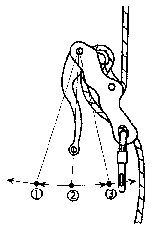|
||||||||||||||||||||||||||||
The descenders is one of the following variations of the same basic design:
|
||||||||||||||||||||||||||||
With the exception of the MagiDeal, which I obtained from China, these were all made in Europe by the same company, operating under different names and owners. I could not find any significant dimensional differences between the European versions in the table, and certainly none that justify different rope diameter limits. The Singing Rock DSD Plus is a later modification that has some significant changes, but what is the difference between the, say, the DSD-25, DSD-30, and DSD 30+25? In despair, after seeing a related comment on one of their YouTube videos, I asked the following question:
A historical question: What is the difference between the DSD-25, DSD-30, and DSD DSD 30+25? I'm holding all three and digital calipers as I write this, and there do not seem to be any significant dimensional differences between those three models. The DSD plus is obviously different. What, if anything, am I missing? Thanks in advance!?
Anthron replied as follows:
The differences between them are about European norms development. At the time DSD-25 came to market there wasn't any norm for descenders yet. After EN 341 was published it was decided to rename the device to DSD-30. It was not a very intuitive move, but after the publication of EN 12841 and DSD demonstrating conformity with it, the same descender became DSD 30+25 (now conforming to both EN 341 and EN 12841 C). In 2011 an update to the norm EN 341 was issued. This was much stricter in terms of requirements and an update to the device was necessary. Thus the DSD plus and DSD pro were developed. The DSD 30+25 currently keeps conformity with EN 12841 C (with a valid certificate) but is obsolete according to EN 341:2011.
 These descenders are designed for single ropes.
The bollards are on a pivoting frame. When the handle is released,
the rope tension pulls the bollards inward, squeezing the rope
between the upper bollard and a third bollard (not visible) mounted
on the handle pivot. This stops the rappeller, although it doesn't
work unless there is tension on the rope below the rappeller (i.e.,
don't count on it working at the end of a drop). Squeezing the
handle forces the bollard assembly to rotate outward, allowing
one to descend. Squeezing the handle further squeezes the rope
between the handle and an auxiliary bar on the bollard assembly,
again causing the rappeller to stop. The entire system relies
on squeezing the handle enough, but not too much (position 2),
so that if the rappeller either lets go (position 1) or panics
and over-squeezes (position 3), they will stop. I find these types
of systems take getting used to, and in my mind are somewhat of
a nuisance, but that is a personal preference that some others
don't share. For a variety of reasons, I prefer not to rely on auto-stop features in any descender.
These descenders are designed for single ropes.
The bollards are on a pivoting frame. When the handle is released,
the rope tension pulls the bollards inward, squeezing the rope
between the upper bollard and a third bollard (not visible) mounted
on the handle pivot. This stops the rappeller, although it doesn't
work unless there is tension on the rope below the rappeller (i.e.,
don't count on it working at the end of a drop). Squeezing the
handle forces the bollard assembly to rotate outward, allowing
one to descend. Squeezing the handle further squeezes the rope
between the handle and an auxiliary bar on the bollard assembly,
again causing the rappeller to stop. The entire system relies
on squeezing the handle enough, but not too much (position 2),
so that if the rappeller either lets go (position 1) or panics
and over-squeezes (position 3), they will stop. I find these types
of systems take getting used to, and in my mind are somewhat of
a nuisance, but that is a personal preference that some others
don't share. For a variety of reasons, I prefer not to rely on auto-stop features in any descender.
Note that the tail end of the rope is trapped instead of hanging
free from the upper bollard like it does on many other bobbins.
This eliminates the need to add a second maillon or rapide as
shown on the Bobbins: General Comments
page.